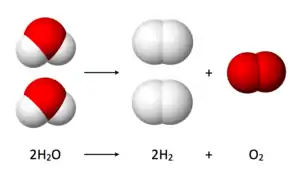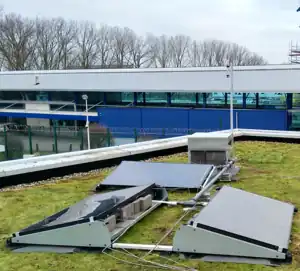Solar hydrogen panel
A solar hydrogen panel is a device for artificial photosynthesis that produces photohydrogen directly from sunlight and water vapor utilizing photocatalytic water splitting and thus bypasses the conversion losses of the classical solar–hydrogen energy cycle where solar power is first harvested with solar panels and only then converted to hydrogen with electrolysis plants.


In the solar hydrogen panel the hydrogen and oxygen evolution reactions are performed in the gas phase in cathode and anode compartments separated by a membrane. Anion exchange membranes provide an alkaline environment enabling the use of earth abundant materials as electrocatalysts.[1]
Scientists at KU Leuven's Center for Surface Chemistry and Catalysis in Leuven, Belgium have managed to produce a solar hydrogen panel, which is able to directly convert no less than 15 per cent of sunlight into hydrogen gas, which according to them is a world record.[1][2][3] According to IEEE Spectrum in 2019 this is a giant leap from 0.1% efficiency 10 years earlier.[3] On 19 February 2021, exactly 2 years after their original reveal of the panel, KU Leuven launched the Solhyd Project and website.[4]
Solar hydrogen panels seem very promising for the green hydrogen economy as this method of producing hydrogen fuel emits no CO2, unlike steam reforming from natural gas and then utilizing the water-gas shift reaction to produce hydrogen. As of 2015 the majority of H
2 worldwide was produced via steam methane reforming, at prices down to $1 / kg H
2.[5] In 2019 the IEA reported that electrolysis of water, another green way to produce hydrogen, accounts for less than 0.1% of global hydrogen production.[6]
The power-to-gas process of producing methane from hydrogen and CO or CO2 is called methanation and produces substitute natural gas. Due to the challenges in hydrogen storage, other methods of energy storage and delivery may be useful, despite the conversion losses in power-to-gas.
See also
- Hydrogen infrastructure
- Timeline of hydrogen technologies
- Liquid hydrogen
- Compressed hydrogen
- Hydrogen vehicle
- Powerpaste, a magnesium and hydrogen -based fluid paste that releases hydrogen when it reacts with water
- Biohydrogen
References
- Heremans, Gino; Trompoukis, Christos (2017). "Vapor-fed solar hydrogen production exceeding 15% efficiency using earth abundant catalysts and anion exchange membrane". Sustainable Energy & Fuels. 1 (10): 2061–2065. doi:10.1039/C7SE00373K. Retrieved 2020-11-09.
- "Green Energy Breakthrough Thanks to KU Leuven Scientists". www.kuleuven.be. Retrieved 2020-11-09.
-
Gallucci, Maria (2019-03-13). "Solar Panel Splits Water to Produce Hydrogen". IEEE Spectrum. IEEE. Retrieved 2020-11-09.
A research team in Belgium says its prototype panel can produce 250 liters of hydrogen gas per day
-
"The Solhyd project is launched!". solhyd.org. KU Leuven. 2021-02-19. Retrieved 2021-03-19.
The idea is simple: get water vapor from the air and energy from the sun, which enables you to make green hydrogen anywhere in the world.
- Rongé, Jan; Bosserez, Tom (2015). "Solar Hydrogen Reaching Maturity". Oil & Gas Science and Technology. 70 (5): 863–876. doi:10.2516/ogst/2014061. Retrieved 2020-11-09.
- "The Future of Hydrogen". iea.org. International Energy Agency. June 2019. Retrieved 2021-03-19.
.
External links
- Official website of the Solhyd Project by KU Leuven
- A news article 'Green energy breakthrough thanks to KU Leuven scientists' at stories.kuleuven.be (2019-10-02)
- 'Sustainable production of hydrogen gas' video by KU Leuven in Dutch with English subtitling on YouTube (2019-03-25)
- An interview 'Looking past the hype: KU Leuven researchers shed more light on their hydrogen panel' with Johan Martens and Tom Bosserez at nieuws.kuleuven.be (2019-03-25)
- 'Surface Chemistry and Catalysis: Characterisation and Application Team (COK-KAT)' in the organizational chart of kuleuven.be
- Solar System Installation